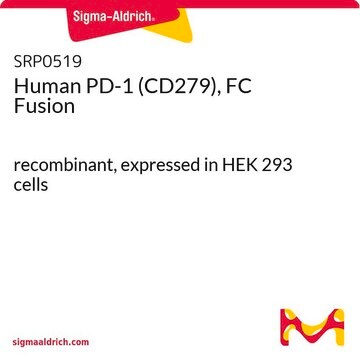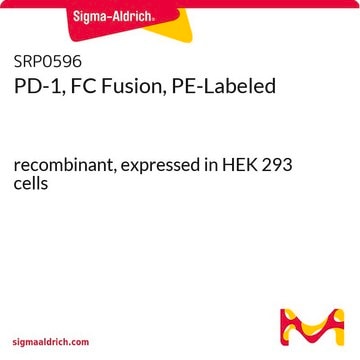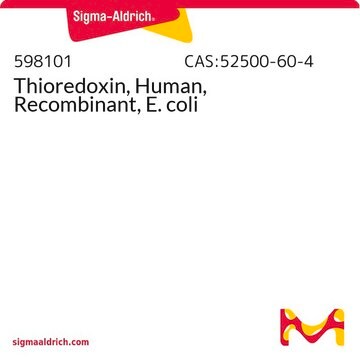SRP6082
TRXB from Escherichia coli
recombinant, expressed in E. coli, ≥90% (SDS-PAGE)
Synonym(s):
TRXR, Thioredoxin reductase
Sign Into View Organizational & Contract Pricing
All Photos(1)
About This Item
UNSPSC Code:
12352200
NACRES:
NA.32
Recommended Products
biological source
Escherichia coli
recombinant
expressed in E. coli
Assay
≥90% (SDS-PAGE)
form
liquid
mol wt
34.6 kDa
packaging
pkg of 100 μg
NCBI accession no.
shipped in
dry ice
storage temp.
−70°C
Gene Information
Escherichia coli ... TRXB(949054)
General description
Thioredoxin reductase (TrxR) is encoded by TRXB gene. TrxR is one of the member of flavoprotein family of pyridine nucleotide-disulphide oxidoreductases, which also includes lipoamide dehydrogenase, glutathione reductase and mercuric ion reductase. Escherichia coli TrxR is a 70-kDa homodimeric flavoprotein, each monomer of this protein contains a FAD prosthetic group, an NADPH domain and an active site with redox-active disulphide. The catalytic site (-Cys-Ala-Thr-Cys-) in Escherichia coli TrxB is localized on the NADPH domain, whereas in humans TrxB catalytic site (-Cys-Val-Asn-Val-Gly-Cys-) is part of the FAD domain.
Biochem/physiol Actions
Thioredoxin reductase (TRXB) catalyzes the reduction of oxidized thioredoxin using nicotinamide adenine dinucleotide phosphate (NADPH). In thioredoxin pathway, this reduced thioredoxin reduce disulfide bonds in proteins localized in the cytoplasm and is implicated in the recycling of an essential enzyme ribonucleotide reductase. TrxR is essentially involved in protection against oxidation stress, cell growth and transformation, and the recycling of ascorbate from its oxidized form.
Physical form
1 mg/mL solution in 20 mM Tris-HCl buffer (pH 8.0) containing 10% glycerol and 1mM DTT.
Preparation Note
Centrifuge the vial prior to opening.
Other Notes
MGTTKHSKLL ILGSGPAGYT AAVYAARANL QPVLITGMEK GGQLTTTTEV ENWPGDPNDL TGPLLMERMH EHATKFETEI IFDHINKVDL QNRPFRLNGD NGEYTCDALI IATGASARYL GLPSEEAFKG RGVSACATCD GFFYRNQKVA VIGGGNTAVE EALYLSNIAS EVHLIHRRDG FRAEKILIKR LMDKVENGNI ILHTNRTLEE VTGDQMGVTG VRLRDTQNSD NIESLDVAGL FVAIGHSPNT AIFEGQLELE NGYIKVQSGI HGNATQTSIP GVFAAGDVMD HIYRQAITSA GTGCMAALDA ERYLDGLADA K.
Signal Word
Warning
Hazard Statements
Precautionary Statements
Hazard Classifications
Eye Irrit. 2
Storage Class Code
11 - Combustible Solids
WGK
WGK 3
Flash Point(F)
Not applicable
Flash Point(C)
Not applicable
Certificates of Analysis (COA)
Search for Certificates of Analysis (COA) by entering the products Lot/Batch Number. Lot and Batch Numbers can be found on a product’s label following the words ‘Lot’ or ‘Batch’.
Already Own This Product?
Find documentation for the products that you have recently purchased in the Document Library.
Characterization of two active site mutations of thioredoxin reductase from Escherichia coli.
Prongay AJ
The Journal of Biological Chemistry, 264(5), 2656-2664 (1989)
Thioredoxin reductase
Debbie MUSTACICH and Garth POWIS
The Biochemical Journal, 346, 1-8 (2000)
E S Arnér et al.
European journal of biochemistry, 267(20), 6102-6109 (2000-09-30)
Thioredoxin, thioredoxin reductase and NADPH, the thioredoxin system, is ubiquitous from Archea to man. Thioredoxins, with a dithiol/disulfide active site (CGPC) are the major cellular protein disulfide reductases; they therefore also serve as electron donors for enzymes such as ribonucleotide
Our team of scientists has experience in all areas of research including Life Science, Material Science, Chemical Synthesis, Chromatography, Analytical and many others.
Contact Technical Service









